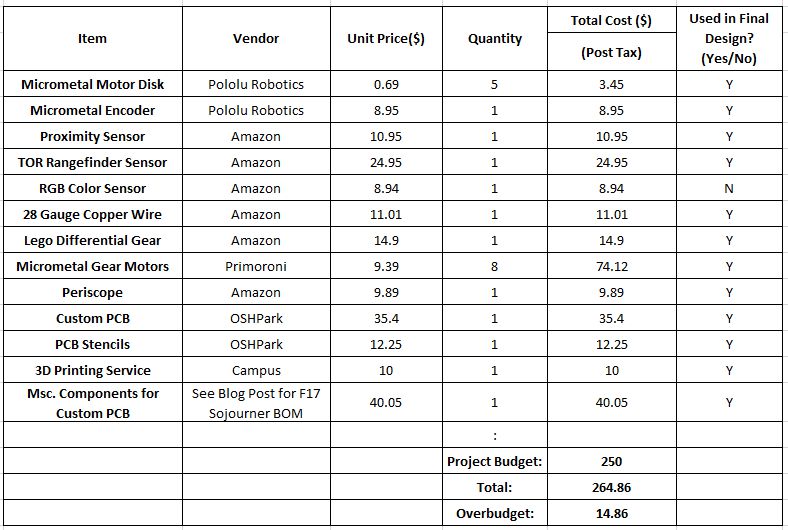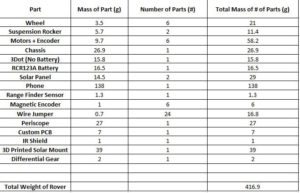Sojourner Fall 2017: Final Blog Post
Fall 2017 Sojourner Team:
Daniel Yeldell (Project Manager)
Piyush Jain (Mission, Systems, and Test)
Malak Alamad (Design and Manufacturing)
Zachary Oyog (Electronics and Control)
Table of Contents:
Project Overview
By: Daniel Yeldell (Project Manager)
Program Objectives
By: Daniel Yeldell (Project Manager)
The Sojourner is a 6 wheeled rover that is capable of autonomous travel on a Mars-like environment. For the mission a Mars-like world is defined to be a rocky surface that can reach the higher peaks of the temperature of Mars. To travel over this terrain, its mechanical system will utilize a “rocker bogie” suspension system and a differential gearbox. The rover will be powered by a battery/solar-panel charging module. A single operator will be able to control the robot in its mission and view the mission .
Mission Profile
By: Daniel Yeldell (Project Manager)
The Sojourner mission for Fall 2017 was to travel through a maze as defined by the customer. This maze for the final mission a 2D print with green lines to represent a maze hallway, and a black grid as guide markings for the rover to follow. The goal of the mission was for the rover to be able to take two different trips through the maze: one with remote assistance, and a second autonomous trip. The rover was designed to be capable of making the autonomous trip through the maze simultaneously with other robots.
System Design
By: Piyush Jain ( Mission, Systems & Test) and Daniel Yeldell (Project Manager)
Level 1 Requirments
By: Daniel Yeldell (Project Manager)
- C1 – Sojourner shall be completed by Wednesday, December 13, 2017
- C2 – Sojourner will be controlled by a 3DoT board.
- C3 – Sojourner will be a toy robot
- C4 – The Sojourner will be controlled by the ARxRobot Android or iPhone Application
- C5 – Sojourner will use a solar panel as part of its power system
- C6 – The design of Sojourner will be modular, being able to be assembled and disassembled within 20 minutes
- C7 – Project Sojourner shall be able to navigate a multi-colored maze with user-defined inputs
- C8 – Sojourner shall be able to navigate said user-defined maze path autonomously
- C9 – 3D printing times shall be limited to a total of 6 hours, with no print taking more than 2 hours to complete
- C10 – The Sojourner shall avoid collisions with other robots
- L1-1 – The budget cost shall be less than $250.00
- L1-2 – Sojourner will incorporate live video feed using a smartphone and periscope placed on top of Sojourner
- L1-3 – The Sojourner will be a scaled-down version of the Pathfinder Rover
- L1-4 – Project Sojourner should utilize a slip differential with dual rear motors using a differential gearbox
- L1-5 – Sojourner should be able to travel on a Mars-like environment
- L1-6 – Project Sojourner shall utilize an electronic differential
- L1-7 – Sojourner will use 6 wheels with a Rocker boogie suspension system
Level 2 Requirments
By: Piyush Jain ( Mission, Systems & Test)
- L2-1 – The Sojourner shall use the IR Proximity sensor to detect other robots x inches in front
- L2-2 – The design will have an area for a smartphone to be placed on
- L2-3 – The Sojourner will use 6 identical wheels for movement, with each wheel having its own motor.
- L2-4 – The solar panel will be attached to the chassis. The solar panels will have no other components covering it for full sunlight acquisition.
- L2-5 – The Sojourner will have 2 separate sections incorporating the modular design. The chassis, motor, wheels, 3Dot board, and H-bridge should be in 1 module, while the solar panels and phone holder should make up the 2nd module.
- L2-6 – The wheels will be cleated, which assist in traversing terrain with soft sand and rocks. This allows for mobility in an environment similar to Mars
- L2-7 – The Sojourner shall use 2 IR sensors to detect and follow the black lines using the line following algorithm.
- L2-8 – The Sojourner will have dimensions of 8.4cm(L) x 3.8cm (W) x 3.4cm (H)
- L2-9 – The Sojourner shall use the robot avoidance algorithm whenever a robot has entered the IR proximity sensor’s detection zone
- L2-10 – The solar panel will recharge the 3.6V RCR123A battery on the 3DoT Board.
Sub-System Design
By: Piyush Jain ( Mission, Systems & Test)
Interface Definition
By: Piyush Jain (Mission, Systems, & Tests)
The interface definition describes how the electronic aspects of Sojourner are connected. The interface definition keeps track of which pins have been used and which ones are available. Keeping track of the pin usage gives the user the ability modify the coding of the project as needed. The interface definition includes the 3DoT board, the custom PCB, the x type of motors, and any other peripheral systems.
Mission Command and Control
By: Piyush Jain (Mission, Systems, & Tests)
Click here to add your own text
Electronics Design
By: Zachary Oyog (Electronics and Control)
Click here to add your own text
Firmware
By: Daniel Yeldell (Project Manager) & Zachary Oyog (Electronics and Control)
Click here to add your own text
PCB Schematic
Zachary Oyog (Electronics and Control)
Click here to add your own text
PCB Layout
By Zachary Oyog (Electronics and Control) and Malak Alamad(Manufacturing and Design)
In the PCB blog post, the PCB layout is depicted in an image taken from the EagleCAD board design. The design was based off of the design that last semester used, with minor modifications made to tend to our needs. The positioning and traces were redone, along with the dimensions and sizing. A more in-depth description is available in the link below.
Hardware Design
By Malak Alamad(Manufacturing and Design)
In the SolidWorks blog post, photos of each design are shown, along with a brief description of the thought process and the need behind each part. The post also includes the completed assembly of the rover and the pull-apart diagram for all of the components. A more in-depth description is available in the link below.
Remaining Manufacturing Blog Posts:
By Malak Alamad(Manufacturing and Design)
Verfication and Validation Summary
By Piyush Jain (Mission, Systems and Test)
Click here to add your own text
Click here to add your own text
Project Status
By: Daniel Yeldell (Project Manager)
Piyush Jain ( Mission, Systems, & Tests)
An important aspect of any project is to track the resources used and available. Resources include: budget, 3D printing purchase orders, power consumption, mass report, and project schedule.
Final Budget Report
By Daniel Yeldell (Project Manager)
The following table is a cost report which includes all parts that were reimbursed by the customer. There is a column which notes which parts were included in the final rover design.
The final project budget was $264.86. The budget allotment set by the customer was exceeded by $14.86.
Power Allocation Report
By Piyush Jain (Mission, Systems, and Test) and Zachary Oyog (Electronics and Control)
The power budget details the current consumption of all the electronic aspects of Project Sojourner. Keeping track of the current consumption is vital because the RCC123A recharge battery has a max current rating of 1320 mA. Sojourner’s electronic components total current consumption cannot exceed this value with a failure to do so will result in Sojourner not working.
Mass Report
By Daniel Yeldell (Project Manager)
The Sojourner team documented a mass report for use by teams creating future versions of the rover.
Project Schedule
By Daniel Yeldell (Project Manager)
Burndown Chart
By Daniel Yeldell (Project Manager)
Concluding Thoughts
By Daniel Yeldell (Project Manager)
Click here to add your own text
Project Resources
PCB Schematic:
Code:
Project Budget:



